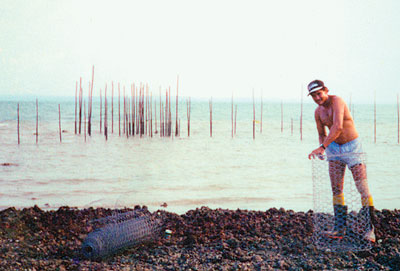Once upon a time, there was a buzz of excitement and talk that echoed through the streets and homes of Darwin. This frenzied movement of people indicated that the fish trap hunters had returned! Bush telegraph was alive and well during those times. As a result, a gathering would culminate at a well known residence and then the bartering, haggling, and negotiations would begin! The reason: fresh fish, crabs, the odd prawns and other marine edibles were on sale. The women mainly controlled this part, for they were the bargain hunters and could square a deal even with the sweetest-talking miser. Women played a significant role in the fish trap business. This was the life of good old Darwin. It was the time when fish traps were operated by local people, for local people, and when money was scarce. Money is still scarce today, but the fish traps are no longer. The government told us “they are illegal”. “They are an eyesore”, “hazardous to other fishing craft”, and “impact on the crab and barramundi industry” were other comments made in opposition to the fish trap. We asked ourselves, is it because “they” have determined that fish traps impact on “their” business?
. . . nothing in . . . this Act . . . shall limit the right of Aboriginals who have traditionally used the resources of an area of land or water in a traditional manner from continuing to use those resources in that area in that manner.
Fisheries Act 1988 (NT)1

Geoffrey Angeles bags a barracuda. Gumboots protect against stonefish, stingrays, crabs, blue-ringed octopus, box jellyfish and other “nasties” in our tropical waters.
Fish, crabs, prawns, a variety of shellfish and other inland bush tucker were being consumed on a regular basis. Without realising it at the time, we had a rather healthy lifestyle. Routinely clearing the trap, along with some maintenance, ensured a regular exercise regime, plus some of these foods consumed had medicinal qualities.
Thus it is to this diet (traditional hunter-gatherer) and life style that we should turn when seeking explanations for (and solutions to) the characteristic pattern of chronic disease which emerges in all populations when they become more affluent economically and adopt a sedentary, westernized way of life.2
Today . . . unfortunately, and sadly, many of our people are suffering from an increase in a variety of chronic conditions ranging from cancers, diabetes, heart disease and stroke to other debilitating illnesses — associated with poor diet, reduced activities and exercise, and other unhealthy lifestyle habits.
More effort and a greater level of importance needs to be directed towards strategies in practical and inexpensive prevention. There is nothing wrong with some of the old and a little bit of the new. Reconciliation comes in many forms, but basically it is about bringing together, compromise, resolution and understanding. Shaking hands and saying sorry is surface stuff. Examples of partnerships that work are more real.
As a young boy growing up in Darwin, it was quite rare to see someone in a wheelchair. I remember an uncle having one leg, but he lost it as a serviceman in the war. He walked with his wooden leg and also played tricks on us as kids. Multiple amputations because of diabetes were virtually unheard of in the old days. Why was this? Could it be because of the diet back then, together with an abundance and sustainment of activities, such as sport, hunting, fishing and other regular recreational events?
Australian Aborigines develop a high frequency of type-2 diabetes when they make the transition from a traditional to an urban life-style.3
If we were to turn back the clock, or gather data from yesterday, the answer or solution to many of today’s chronic ailments may lie in waiting.

Donald (“Dookie”) Bonson using chicken-wire to make baskets to carry the fish. Fish trap in background.
Today we have an increasing trend towards youth dysfunction associated with crime, violence, suicide and other associated factors. Is this linked to varying forms of mental illness associated with limited family connectedness, negative peer group pressure, or some early childhood abuse or neglect? Maybe it’s the hyperactivity of the “neon world” which attracts and lures them like moths to bright lights. This may momentarily help blanket out or blur the vision of a fragmented childhood, but they still have to wake up the next day. Development, tourism, a fast pace, and a “keeping up with the rest” attitude can leave a drastic legacy in its wake. If you can’t keep up or don’t fit in, you get left behind and easily forgotten. So how can we create and foster a healthier lifestyle for a healthier next generation? Our children and young people need adventure, excitement, nurturing and opportunity in all the right ways. Until such time as someone comes up with real activities for excitement-starved youth, they will be encouraged and persuaded to seek other good things in the neon world . . . but at an unhealthy price! Things like drugs, alcohol, adolescent pregnancy, aggressiveness and, eventually, low self-esteem are the result.
Gather up all youths who work for the dole or who are on a community development employment program and ask those wanting to mow lawns, pick up rubbish, do sweeping, hedging, etc, to move to the left. Then ask those wanting to fish and learn about Indigenous coastal and land management practices, including Indigenous health and wellbeing, to move to the right. What would you pick?
The fish trap business will create a feeling of achievement, pride, identity, a sense of belonging and something a bit more significant as far as contributing to community health and wellbeing is concerned.





